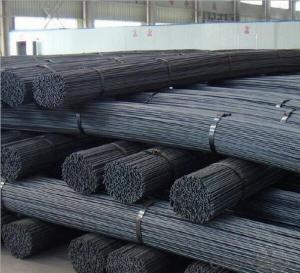HRB 400/ 500 Reinforcing Deformed Steel Round Bar with Cheap Price
- Loading Port:
- Tianjin
- Payment Terms:
- TT OR LC
- Min Order Qty:
- 100 m.t.
- Supply Capability:
- 100000 m.t./month
OKorder Service Pledge
OKorder Financial Service
You Might Also Like
Item specifice
HRB 400/ 500 Reinforcing Deformed Steel Round Bar with Cheap Price
Products Description:
1. Diameter: 5.5mm-10mm rounds reinforcing steel bar
10m- 40 rods reinforcing deformed steel bar
2. Length: 6m, 9m, 12m or customized
3. Standard: GB, ASTM, AISI, SAE, DIN, JIS, EN. OEM technology - send detailed technical parameters for accurate quotation.
4. Produce Process: smelt iron - EAF smelt billet - ESR smelt billet - hot rolled or forged to get the steel round bar and plate
5. Heat Treatment: annealing, normalizing, tempering, quenching
6. Surface Treatment: Black
7. Quality Assurance: We accept third party inspection for all orders.
You can ask testing organizations such as SGS, BV, etc. to test our products before shipping.
Theoretical weight and section area:
| Diameter(mm) | Section area (mm²) | Mass(kg/m) | Weight of 12m bar(kg) |
6 | 28.27 | 0.222 | 2.664 |
| 8 | 50.27 | 0.395 | 4.74 |
| 12 | 113.1 | 0.888 | 10.656 |
| 16 | 201.1 | 1.58 | 18.96 |
| 20 | 314.2 | 2.47 | 29.64 |
| 25 | 490.9 | 3.85 | 46.2 |
| 32 | 804.2 | 6.31 | 75.72 |
| 40 | 1257 | 9.87 | 118.44 |
| 50 | 1964 | 15.42 | 185.04 |
Technical Datas:
Grade | Technical data of the original chemical composition (%) | |||||
| C | Mn | Si | S | P | V | |
| ≤0.25 | ≤1.60 | ≤0.80 | ≤0.045 | ≤0.045 | 0.04-0.12 | |
HRB400 | Physical capability | |||||
| Yield Strength (N/cm²) | Tensile Strength (N/cm²) | Elongation (%) | ||||
| ≥400 | ≥570 | ≥14 | ||||
Products Show:
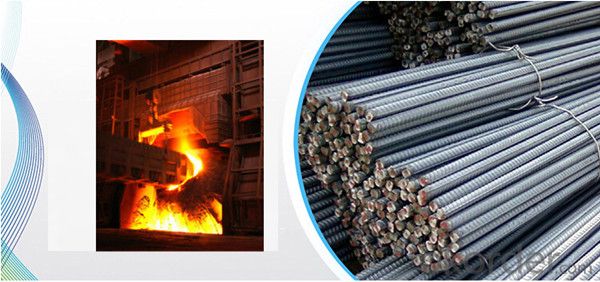
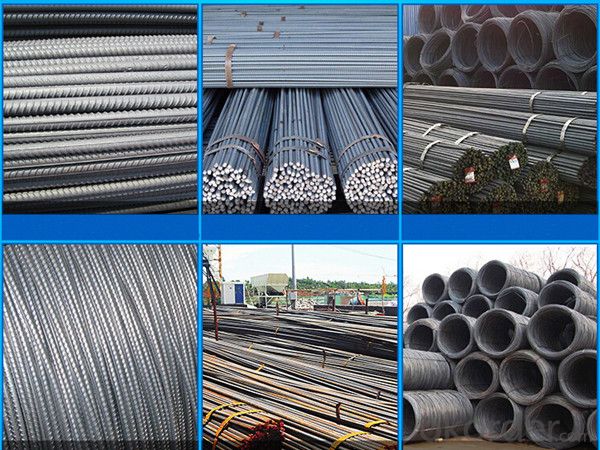
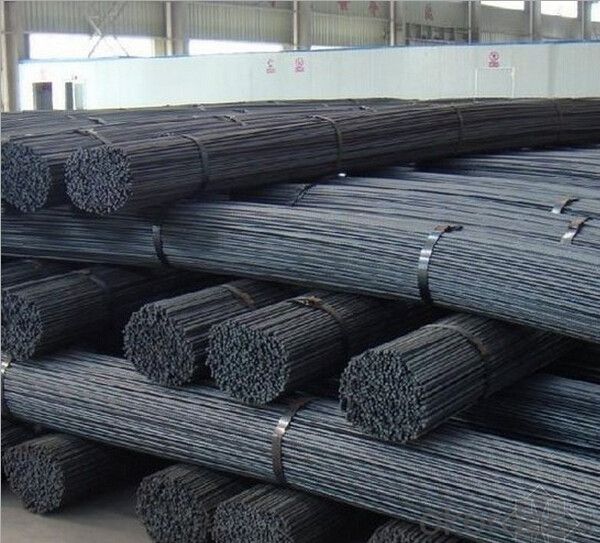
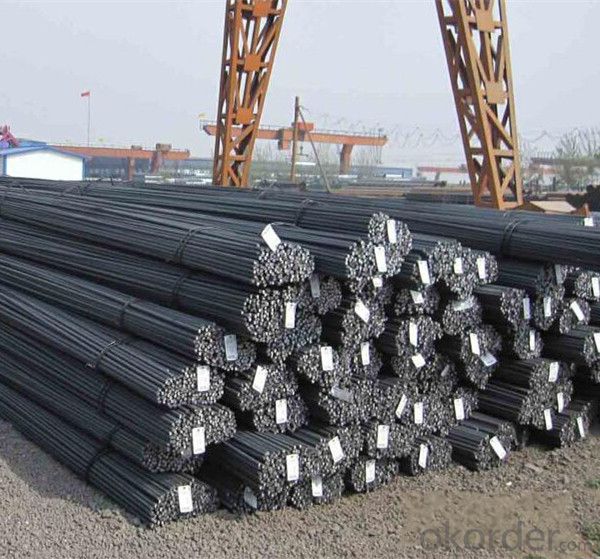
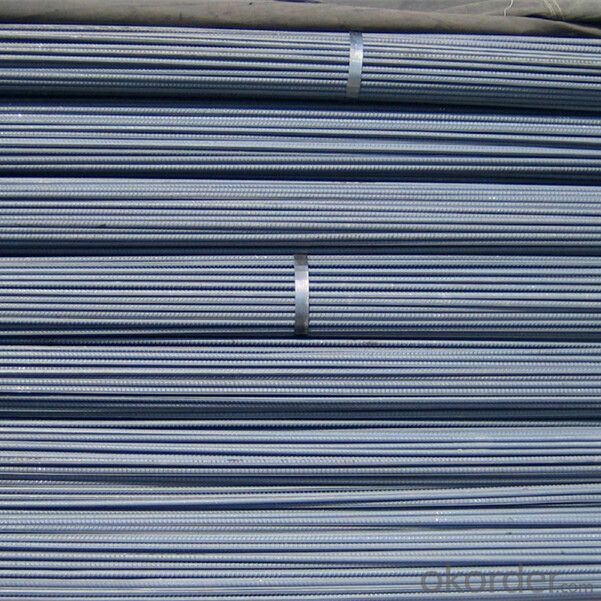
Packages and Shipping:


FAQ:
1. Your advantages?
Professional products inquiry, products knowledge train (for agents), smooth goods delivery, excellent customer solution proposale
2. Test & Certificate?
SGS test is available, customer inspection before shipping is welcome, third party inspection is no problem
3. Payment Terms?
30% TT as deposit and 70% before delivery. Or Irrevocable L/C at sight.
4. Trading Terms?
EXW, FOB, CIF, FFR, CNF
5. After-sale Service
We provide the services and support you need for every step of our cooperation. We're the business partner you can trust. For any problem, please kindly contact us at any your convenient time.
- Q:How do steel rebars affect the overall construction schedule?
- Steel rebars can have a significant impact on the overall construction schedule. They are essential components in concrete structures, providing strength and stability. However, their installation can be time-consuming as it requires careful placement and securing. Delays in rebar installation can potentially affect subsequent construction activities, such as concrete pouring and curing. Therefore, efficient planning and coordination of rebar installation are crucial to ensure the construction schedule remains on track.
- Q:How are steel rebars used in the construction of tunnels and underground passages?
- Steel rebars, also known as reinforcing bars, are indispensable in the construction of tunnels and underground passages. They provide essential strength and stability to the concrete structure. In tunnel construction, rebars are strategically placed within the concrete to reinforce it and prevent cracking or collapsing. The rebars act as a framework for the concrete, distributing the load and reinforcing its structural integrity. They are typically arranged in a grid pattern throughout the tunnel walls, floor, and ceiling. One of the main reasons for using rebars in tunnel construction is their ability to withstand tension forces. Tunnels face significant pressure from the surrounding soil and water, and without proper reinforcement, the concrete would easily crack under this pressure. By adding steel rebars, the concrete's tensile strength is greatly increased, ensuring it can withstand external forces. Furthermore, rebars also play a crucial role in controlling and preventing crack propagation. If a crack occurs, the rebars act as a barrier, preventing the crack from spreading throughout the structure. This is particularly important in tunnels and underground passages, as any weakening of the concrete could jeopardize the safety of the structure and its users. Moreover, rebars are used to reinforce specific areas of the tunnel that are more susceptible to stress, such as corners, joints, and areas where heavy equipment or vehicles may pass through. By reinforcing these critical points with steel rebars, the overall structural integrity of the tunnel is significantly enhanced. In conclusion, the use of steel rebars in tunnel and underground passage construction is essential for ensuring the strength, stability, and long-term durability of these structures. They play a vital role in preventing cracking, controlling crack propagation, and enhancing the overall durability of the concrete.
- Q:What are the limitations of using steel rebars?
- There are several limitations associated with using steel rebars in construction projects. Firstly, steel rebars are susceptible to corrosion. When exposed to moisture and oxygen, they can start to rust over time. This corrosion weakens the rebars and compromises the structural integrity of the concrete. To mitigate this issue, rebars are usually coated with epoxy or other protective coatings, but these coatings can deteriorate over time and require maintenance. Secondly, steel rebars have a high thermal expansion coefficient. This means that they expand and contract significantly with changes in temperature. This can lead to stress and cracking in the concrete, particularly in regions with extreme temperature variations. To minimize these effects, engineers often use expansion joints or other techniques to accommodate the thermal expansion of the rebars. Additionally, steel rebars are heavy and can be challenging to handle and transport. Their weight can increase the overall weight of the structure, which may require additional support or reinforcement. Moreover, the transportation of steel rebars to construction sites can be costly and time-consuming. Furthermore, steel rebars are a finite resource and their production has an environmental impact. The extraction and production of steel require significant amounts of energy and can contribute to greenhouse gas emissions. Additionally, the depletion of natural resources required for steel production is a concern. Lastly, steel rebars are conductive to heat and electricity, which can pose safety risks in certain situations. For example, in areas prone to lightning strikes, the presence of steel rebars can increase the likelihood of electrical damage. In conclusion, while steel rebars are widely used in construction due to their strength and durability, they have limitations such as susceptibility to corrosion, thermal expansion issues, high weight, environmental impact, and electrical conductivity. It is crucial for engineers and architects to consider these limitations and employ appropriate measures to address them in construction projects.
- Q:What are the common manufacturing processes for steel rebars?
- The common manufacturing processes for steel rebars involve several steps to ensure the production of high-quality and durable reinforcement bars. These processes typically include: 1. Melting: The first step in manufacturing steel rebars is melting the raw materials, which usually consist of iron ore, coal, and limestone, in a blast furnace. This process produces molten iron that is then further refined to remove impurities. 2. Casting: Once the molten iron is refined, it is poured into molds to create large billets or blooms. These molds are often called continuous casting machines, where the molten iron solidifies into a rectangular shape. 3. Rolling: The solidified billets or blooms are then heated and passed through rolling mills. The rolling process involves compressing the steel between a series of rollers to reduce its thickness and shape it into the desired dimensions of rebars. This process also helps improve the mechanical properties and eliminate any internal defects or impurities. 4. Quenching and Tempering: After the initial rolling process, the rebars may undergo quenching and tempering. Quenching involves rapidly cooling the steel bars by immersing them in water or oil. This step increases the hardness of the rebars, making them more resistant to deformation and wear. Tempering follows, which involves reheating the quenched bars to a specific temperature and then cooling them slowly. Tempering helps remove internal stresses and improves the toughness of the rebars. 5. Cutting and Coiling: Once the bars have been rolled and heat-treated, they are cut to the desired lengths using cutting machines. The cut rebars are then coiled into bundles or stacked for storage and transportation. 6. Surface Treatment: To enhance the corrosion resistance of rebars, manufacturers often apply a protective coating or surface treatment. This can involve hot-dip galvanizing, where the rebars are immersed in molten zinc to form a zinc coating, or epoxy coating, where a layer of epoxy resin is applied to the rebars. It is important to note that these manufacturing processes may vary depending on the specific requirements and standards set by different countries and industries. However, the aforementioned steps provide a general overview of the common processes involved in manufacturing steel rebars.
- Q:What are the common challenges in handling steel rebars during construction?
- Construction often presents numerous obstacles when it comes to managing steel rebars. One primary hurdle involves the weight and size of the rebars themselves. These metal rods can be quite cumbersome and unwieldy, making it challenging to lift and manipulate them on the construction site. Failing to employ appropriate lifting techniques and equipment can result in worker injuries. Another issue concerns the storage and organization of rebars. Given the various lengths and sizes they come in, it becomes crucial to maintain a well-organized storage area that keeps them separate and easily accessible. Neglecting to do so can lead to construction delays and inefficiencies. Moreover, steel rebars are prone to rust and corrosion if mishandled or stored improperly. Exposing them to moisture, rain, or excessive humidity can cause deterioration, which weakens structures. Therefore, it is vital to safeguard rebars from these elements and store them in a dry, well-ventilated space. Additionally, placing and aligning rebars within concrete structures poses a challenge. This task demands skilled labor and precision to ensure that rebars are correctly positioned according to construction plans. Any errors in placement can compromise the building's structural integrity, leading to safety concerns and expensive repairs. Finally, transporting rebars to the construction site poses a logistical challenge. Coordinating their delivery and ensuring they arrive on time and in the required quantities can be complex, especially in large-scale projects. Delays in receiving rebars can result in project delays and additional costs. In conclusion, effectively managing steel rebars during construction necessitates careful planning, proper storage, skilled labor, and adherence to safety protocols. By addressing these common challenges, construction projects can ensure the successful and efficient utilization of steel rebars.
- Q:Can steel rebars be used in the construction of sports stadiums?
- Yes, steel rebars can be used in the construction of sports stadiums. Steel rebars are commonly used in reinforced concrete structures, providing strength and stability to the overall construction. Sports stadiums require durable and robust structures to accommodate large crowds and withstand various loads, making steel rebars an ideal choice for their construction.
- Q:How do steel rebars affect the overall workability of concrete?
- Steel rebars play a crucial role in enhancing the overall workability of concrete. Workability refers to the ease with which concrete can be mixed, placed, compacted, and finished to achieve the desired shape and surface. When steel rebars are incorporated into concrete, they provide reinforcement and improve its structural strength. The rebars act as a skeleton within the concrete matrix and help distribute the loads and stresses evenly throughout the structure. This reinforcement prevents cracking, enhances the structural integrity, and increases the load-bearing capacity of the concrete. Moreover, steel rebars also help control the shrinkage and cracking of concrete. During the curing process, concrete tends to shrink, which can result in the formation of cracks. The presence of rebars mitigates this issue by counteracting the tensile forces that cause shrinkage and cracking, thus improving the overall durability of the concrete. In addition to their structural benefits, steel rebars also facilitate the workability of concrete during the construction process. The rebars act as guides for proper concrete placement and help prevent segregation or separation of the mix. They ensure that the concrete is properly compacted and eliminates potential voids or air pockets, resulting in a more homogeneous and uniform mixture. Furthermore, steel rebars provide stability and support to the concrete during its curing and hardening stages. They prevent deformation or sagging of the fresh concrete and help maintain its desired shape and form. This is particularly important for complex or intricate structures where precise shaping and positioning of the concrete is necessary. Overall, the inclusion of steel rebars positively affects the workability of concrete by enhancing its structural strength, mitigating shrinkage and cracking, facilitating proper placement and compaction, and providing stability during the curing process. The combination of concrete and steel rebars creates a durable and reliable construction material that can withstand various loads and environmental conditions.
- Q:How are steel rebars used in bridge construction?
- Steel rebars are used in bridge construction to reinforce and strengthen the concrete structures. These rebars are embedded within the concrete to enhance its tensile strength, thereby preventing cracks and ensuring the bridge's overall stability and durability.
- Q:How do steel rebars affect the overall sustainability of a construction project?
- The overall sustainability of a construction project can be significantly influenced by steel rebars. To begin with, steel rebars are commonly employed to reinforce concrete structures, thereby enhancing their strength and durability. This leads to an increase in the longevity of the building, consequently minimizing the necessity for frequent repairs or replacements. As a result, the consumption of materials and energy required for maintenance over the long term is reduced. Additionally, the utilization of steel rebars contributes to the structural integrity of a construction project, enabling the design of lighter and more efficient structures. This, in turn, leads to a reduction in material usage and lower energy consumption during the construction process. Moreover, the use of steel rebars often allows for the construction of slimmer and more aesthetically pleasing structures, which can positively impact the project's environmental footprint. Moreover, steel rebars are recyclable, further enhancing the sustainability of a construction project. At the end of a building's life cycle, it is easy to recover and reuse steel rebars, thereby reducing the demand for new steel production. This not only conserves natural resources but also significantly reduces greenhouse gas emissions associated with the steel manufacturing process. Furthermore, steel rebars can contribute to the overall sustainability of a construction project by improving the building's resilience to natural disasters such as earthquakes or hurricanes. By providing additional strength and flexibility to the structure, steel rebars can help minimize damage and potentially save lives. In conclusion, the usage of steel rebars positively affects the overall sustainability of a construction project by enhancing the structural integrity and durability of buildings, reducing material and energy consumption, promoting recycling and reuse, and improving resilience to natural disasters. Their utilization is a vital component in the creation of more sustainable and environmentally friendly construction practices.
- Q:How do steel rebars affect the overall durability of marine structures?
- Steel rebars play a crucial role in enhancing the overall durability of marine structures. Due to their high tensile strength and corrosion resistance, steel rebars provide structural stability and prevent the degradation of marine structures caused by environmental factors such as saltwater, waves, and harsh weather conditions. One of the main challenges faced by marine structures is corrosion, as the constant exposure to saltwater can significantly weaken the structure over time. Steel rebars, often coated with anti-corrosive materials such as epoxy or galvanized coatings, act as a protective layer against corrosion. This coating prevents the penetration of saltwater and other corrosive agents, ensuring the longevity of the marine structure. Furthermore, steel rebars are known for their high tensile strength, which allows them to withstand the tremendous forces exerted by waves and currents. These rebars provide the necessary reinforcement to the concrete used in marine structures, preventing cracks or failure due to excessive loads. This reinforcement enhances the structural integrity of the marine structure, making it more resilient against external forces. Moreover, steel rebars offer flexibility in design and construction, allowing for the creation of complex and robust marine structures. With the ability to bend and shape rebars as needed, engineers can design structures that are better suited to withstand the unique challenges posed by the marine environment. This flexibility also facilitates the construction process, making it more efficient and cost-effective. Overall, steel rebars significantly contribute to the durability of marine structures by providing corrosion resistance, enhancing structural stability, and enabling innovative design solutions. Their presence ensures the longevity and reliability of marine structures, allowing them to withstand the harsh conditions of the marine environment for extended periods.
1. Manufacturer Overview |
|
|---|---|
| Location | |
| Year Established | |
| Annual Output Value | |
| Main Markets | |
| Company Certifications | |
2. Manufacturer Certificates |
|
|---|---|
| a) Certification Name | |
| Range | |
| Reference | |
| Validity Period | |
3. Manufacturer Capability |
|
|---|---|
| a)Trade Capacity | |
| Nearest Port | |
| Export Percentage | |
| No.of Employees in Trade Department | |
| Language Spoken: | |
| b)Factory Information | |
| Factory Size: | |
| No. of Production Lines | |
| Contract Manufacturing | |
| Product Price Range | |
Send your message to us
HRB 400/ 500 Reinforcing Deformed Steel Round Bar with Cheap Price
- Loading Port:
- Tianjin
- Payment Terms:
- TT OR LC
- Min Order Qty:
- 100 m.t.
- Supply Capability:
- 100000 m.t./month
OKorder Service Pledge
OKorder Financial Service
Similar products
New products
Hot products
Related keywords
